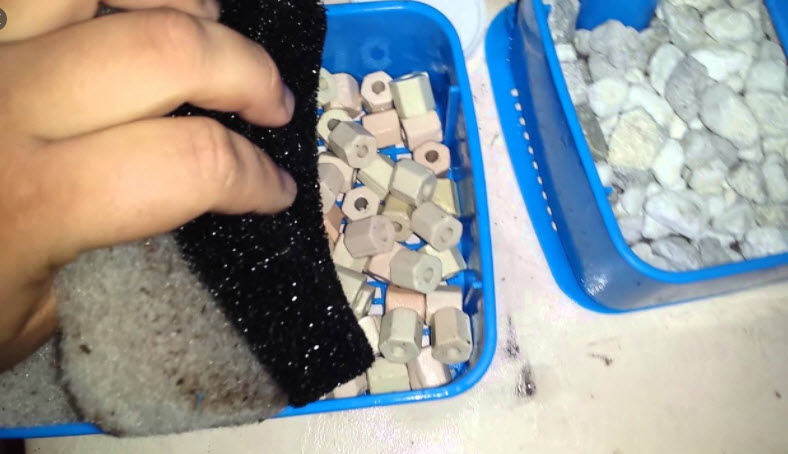
An illustration is in order. If we have a heavily stocked aquarium (one pound of fish) and are using static K1 media for our filter, how big does a canister filter need to be at one month of operation? For this calculation we need a table:
This table show the options available:
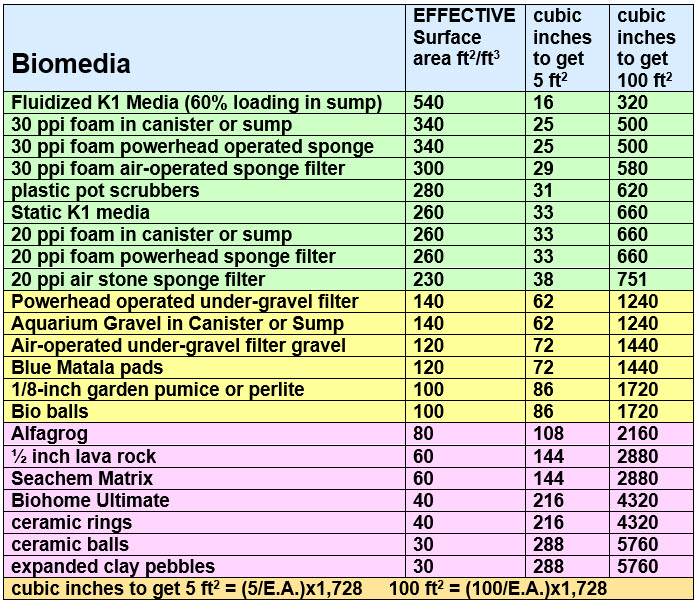
It is important to note that the Fluidized K1 efficiency is per cubic foot of filter, NOT per cubic foot of K1 filter media. Big difference!
Note that the volume of media in gallons can be obtained by multiplying by 0.0043 (7.5 divided by 1728), for liters multiply by 0.016 (28 divided by 1728) and for cubic feet divide by 1728.
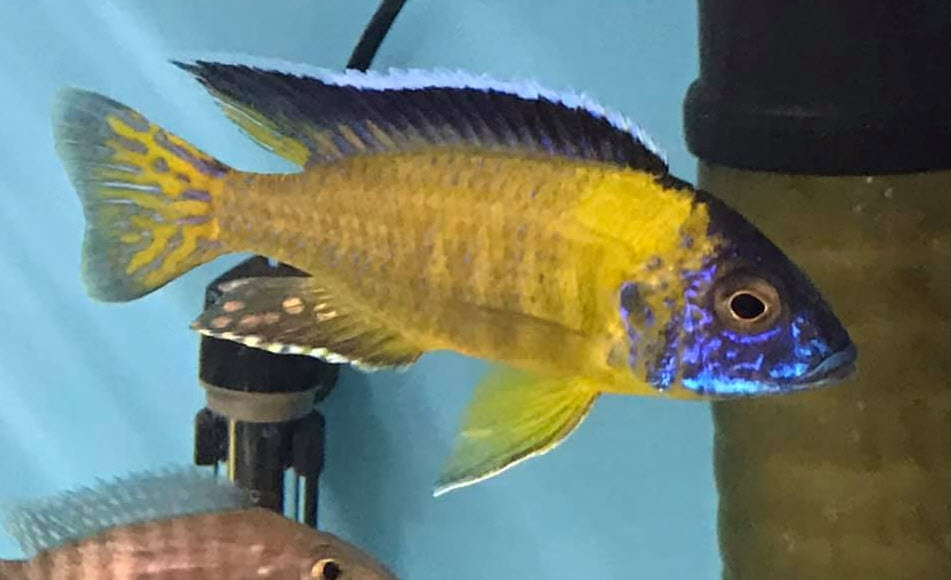
Testing has shown that very roughly ammonia oxidation to nitrate can be done with 5 square feet of media surface per metabolic pound of fish. Other testing established that crystal clear, healthy water required 100 square feet of surface area per metabolic pound of fish.
That means, for “crystal clear” water clarity filtration and healthy fish after one month of operation with one metabolic pound of fish, we need 650 cubic inches of K1 submerged in the stationary submersed static media filter. This is roughly 8 inches by 8 inches by 10 inches of canister filled with K1 media.
For lava rock and Matrix filter media the calculations are surprising. We would need FOUR 8 inches by 8 inches by 10 inch canisters filled with lava rock or Matrix media in order to get crystal clear healthy water.
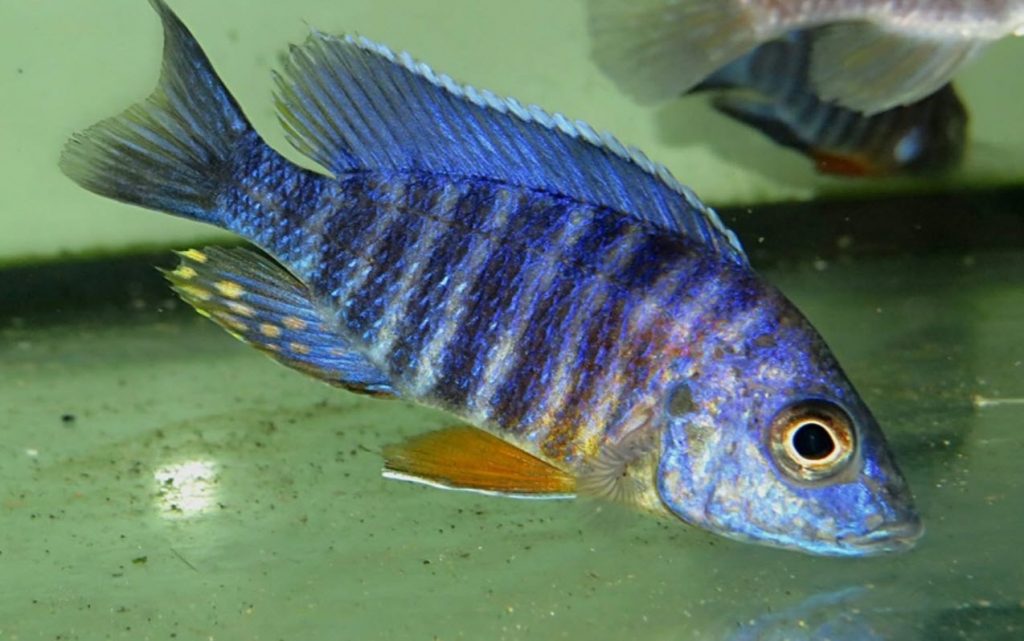
Most commercial sump filters rated for a 100-gallon aquarium (i.e. a forty gallon sump) have a capacity of around four cubic feet. So, they will work very well for filtration if they are filled with K1 media. If they are a fluidized bed design, they become the best filter around, period. They will also work superbly with urethane foam and pot scrubbers.
Also note that these media volumes are for one metabolic pound of fish, about 40 four to five-inch fish. Obviously if one has an eight-pound arowana multiply these numbers by eight. And if you have only ten four to five-inch fish divide it by four.
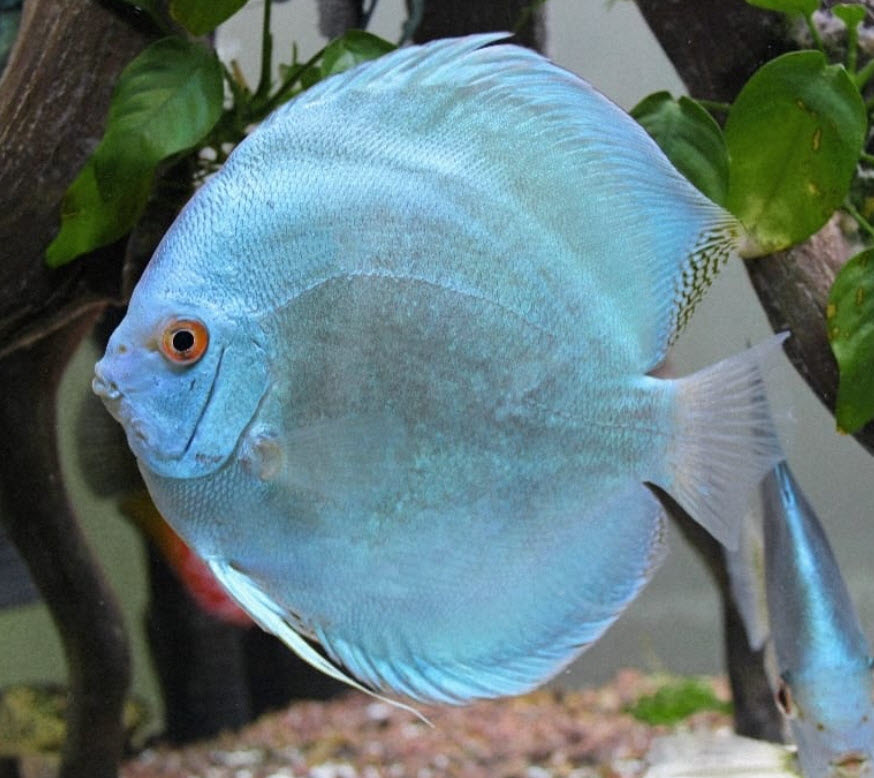
An Illustration
Here is a comment to this web page and its answer:
“Paul
I have a 75-gallon community tank with an EHEIM 2217 canister filter. I’m planning to replace all the EHEIM filter media with Swiss Tropical 20 PPI Poret foam. I’m thinking of having 5 foam pads, each 2” thick and 7” in diameter. Would this give me the 220 sq. ft of effective surface area mentioned in your chart? Using one of your other charts, I calculate that I have 0.75 lbs of fish. Using the 100 sq. ft for 1 lb. of fish metric, I would think I’ll be able to easily accommodate more fish – is that right? I’m planning to use your recommendation to squeeze liquid from the existing filter pads onto the new pads to jump start the cycling of the new foam. How long do you think I should wait before adding more fish? Thanks for your help.
Dave
OK you have a cylinder ten inches tall and 7 inches in diameter. V = π r2 h = π x 3.5 x 3.5 x 10 = 384 This will give one 384 cubic inches of 20 ppi foam. 12x12x12 is 1,728 So you will have 384/1,728 or 0.222 cubic feet. 0.222 x 260 = 49 square feet. So you can do 0.49 pounds of fish at the 100 square foot per pound of fish metric. At the current time you are at (0.49×100)/0.75 = 65 square feet per pound of fish. 65 square feet is good, but it isn’t 100 square feet. So you cannot accommodate more fish.
.
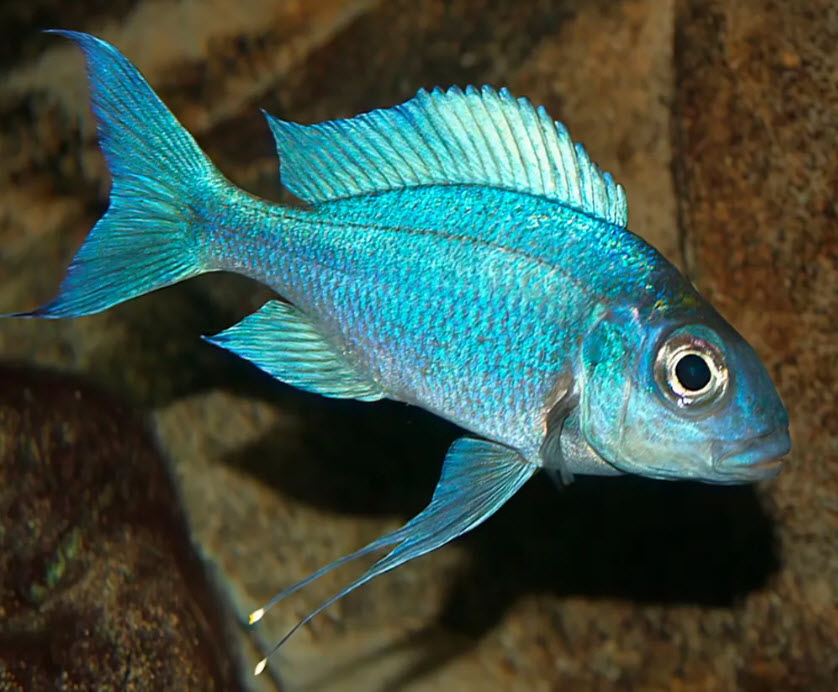
Another Example of Aquarium Filter Media Calculations
This exchange is from the comments section of this website:
Question #1
“Hi there,
I’m reaching out for some clarity on ‘Square Feet of Biomedia Surface Area’. I’m considering the 5″ Poret® Foam Sheets (26 × 19.5″ Sheet) and am wondering what the calculations would be for cubic sq. ft.? I plan on executing the ‘10 ft2/gallon of water’ OR ‘100 ft2/pound of fish.’”
Answer #1
“To calculate the volume the math is 5 inch x 26 inch x 19.5 inch / 12 inch x 12 inch x 12inch = 1.47 cubic feet per sheet of Poret® Foam. With a 20 ppi Poret® foam (what I recommend) which has about 260 square feet of effective surface area per cubic foot, this is 1.47 x 260 = 323 square feet. So If you use the whole sheet of Poret® you can support roughly 3.23 pounds of fish in a healthy environment (100 square feet of surface area per pound of fish). And I don’t recommend “10 ft2/gallon of water”. Go ONLY with the “100 ft2/pound of fish”.
Question #2
“Thank you so much for the reply but I’m still confused. Essentially I’m wondering how many – 5″ deep x 26″ long x 19.5″ high Poret® Foam Sheets, will I need for 13.2 lbs. of fish (24 × 8.8 oz Discus or 24 x 8.8/16)?”
Answer #2
“The calculation for 13.2 pounds of fish is 13.2 pounds divided by 3.23 pounds equals four sheets of 5″ deep x 26″ long x 19.5″ high Poret® Foam”
These examples illustrate the process very well.
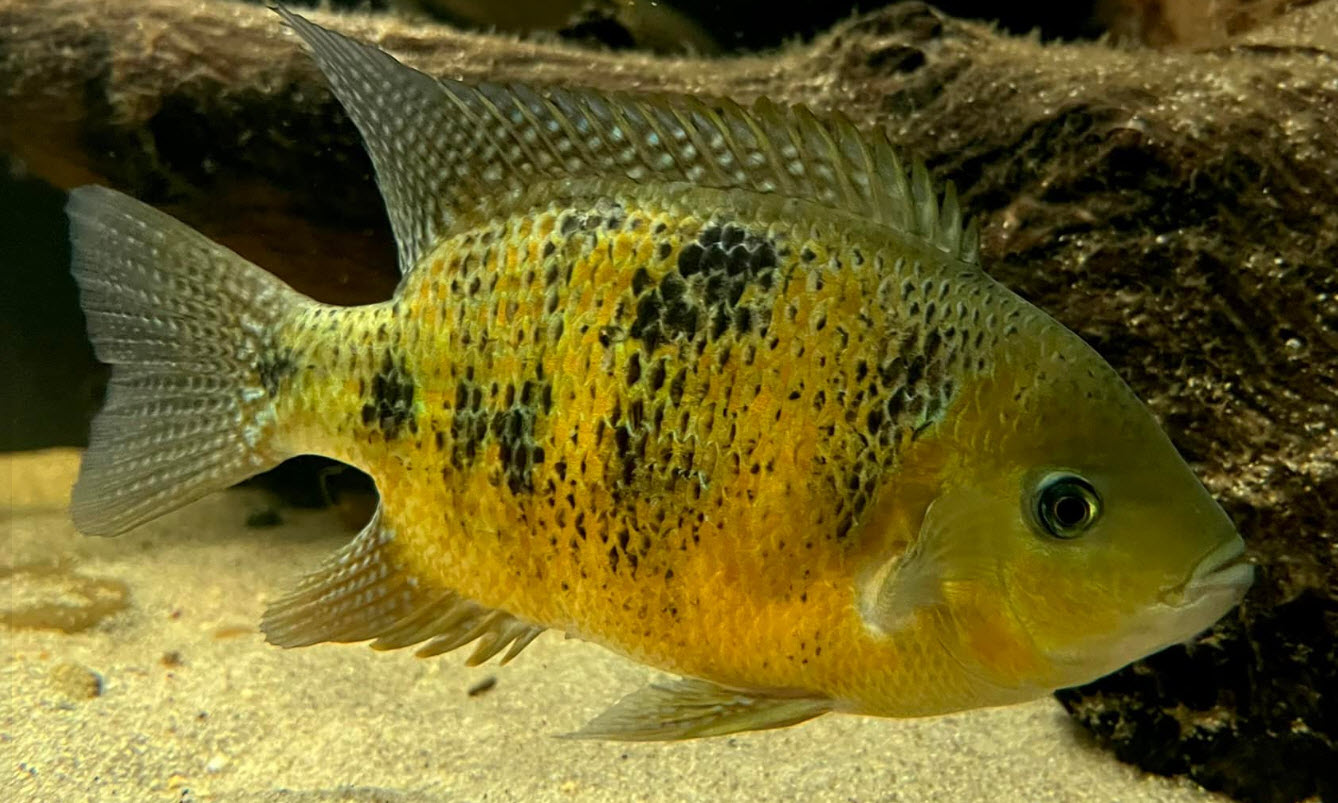
Another Illustration
liam
“I’m currently cycling a 150-160 liter tank which has a sump. In my sump I’m running a foam block for the biological side of filtration which is 12x4x4 inches. It’s a dirtied tank and I’m hoping to have around 20 neon tetras 10 mollys or guppies and a few Cory’s. I’ve been reading on the website about filtration and how foam is one of the best medias for bacterial growth, however I’m unsure if this filter will be big enough to house the bacteria I’ll need?
What are your thoughts please?”
Dave
“In reply to Liam … OK Neons being a very touchy blackwater fish they will need an established filter (i.e. don’t add them for at least three months). When they are added they will need 100 square feet for each pound of fish for the entire stocking. You hit that number almost on the button. 12 x 4 x 4 in inches is 1 x 0.33 x 0.33 = 0.11 cubic feet of foam. Each neon has a metabolic weight of one gram. Each molly and cory (need at least five cory’s) is seven grams metabolic weight. 15 x 7 = 105 105 + 20 = 145 grams 145/454 = 0.32 pounds. 0.32 pounds at 100 square feet per pound is 32 square feet needed. 0.11 cubic inches of foam at 340 square feet per cubic foot is 0.11 x 340 = 37.4 square feet of media. So you have just a little bit more media than you need. This assumes the flow is completely THROUGH the foam and that the foam is 30 pores per inch. Go for it!”
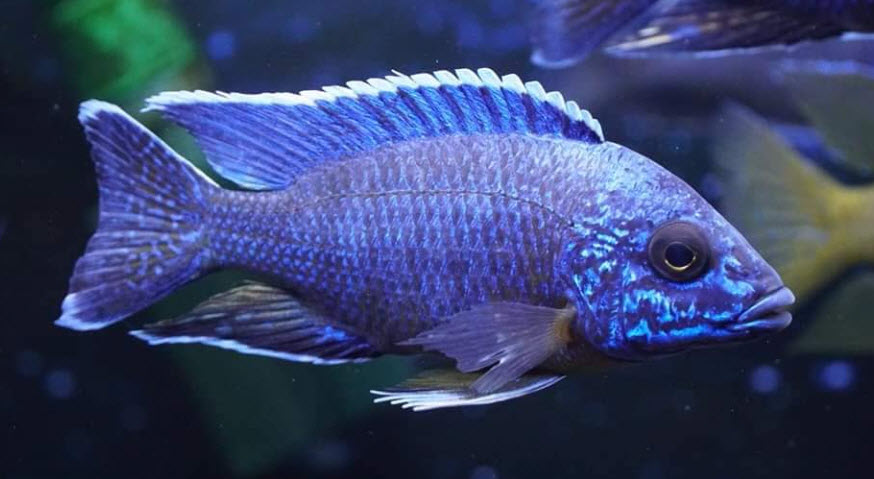
Still another illustration:
Question:
How do you calculate the surface area in media used for biological filtration? For example, I have 30 pot scrubbers and some foam in a Fluval 407 canister filter on a 75 gallon tank.
Reply
OK Each pot scrubber is roughly nine cubic inches of media (large pot scrubbers???). 9×30/12x12x12 = 0.156 cubic feet. Pot scrubbers are 260 square feet per cubic foot media (I could be off on that). 0.156x 260 = 40 square feet from the pot scrubbers. If I remember right a 407 has a piece of 30 ppi foam that is 10 inches x 1 inch x 14 inches. 10x1x12/12x12x12= 0.081 cubic feet Foam is about 340 square feet per cubic feet 0.081×340 = 27.5 square feet. 27.5 + 40 = 67.5 square feet in total. That is just off the top of my head. You need to correct the numbers depending on the size of your pot scrubbers and the true size of the 407 foam.
Topic in More Depth
For more on how to calculate filter volume go to these articles:
8.8.1. Sizing Filters in Depth
7.3. Media Volume
7.6. Required Aquarium Filter Media Surface Area
.
Return to Filters Menu
.
Aquarium Science Website
The chapters shown below or on the right side in maroon lead to close to 400 articles on all aspects of keeping a freshwater aquarium. These articles have NO links to profit making sites and are thus unbiased in their recommendations, unlike all the for-profit sites you will find with Google. Bookmark and browse!
.

Dave says
In reply to Jordan P …. The calculations are for metabolic weight. So ten to twenty mbuna it is (100 square ft per pound to fifty square foot per pound).
Jordan P says
Hi. I’m looking at starting a potential 60 gallon Mbuna tank with smaller mbuna yellow labs, yellow tail, rusty etc around 4 inches long.
I have a large canister filter that has a volume of 500 cubic inches that I plan to fill with K1 media as it’s a difficult shape to cut foams.
As per your stocking table this would allow me around 370 grams of fish. I’m a little bit confused as how to estimate how many fish I can stock? For example a 3-4 inch Mbuna will have a calculated max weight of around 20 grams but a metabolic weight of around 38 grams. Is it always the the metabolic weight we use for stocking? If so am I correct allow around 10 mbuna? Appreciate any clarification you could give me on this!
Dave says
In reply to Johnny Lin …. Just replace the monoballs with the K1. It works great in canisters.
Johnny Lin says
Hi there,
This is Johnny from Taiwan. I’m currently using 2 canisters, separately, in my 180-liter tank. The Eden 521 has a normal setup but the Eheim 2236 is filled with monoballs in order to obtain more beneficial bacterial. After reading some of your articles I’m wondering should I add another canister filled with K1 media or just replace the monoballs with it?
I can’t find similar pot scrubbers locally and that’s why I choose K1 media. Will it work well in a sealed canister? Or pot scrubbers will be a better choice?
Any advice will be appreciated. Thank you.